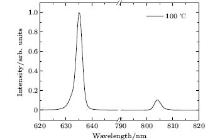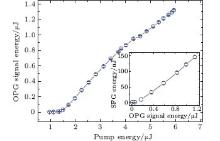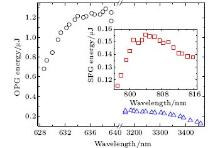Corresponding author. E-mail: bhfeng@iphy.ac.cn
Project supported by the National Basic Research Program of China (Grant No. 2013CB632704).
Tunable coherent emission is generated in a single-pass, cascaded wavelength conversion process from mode-locked laser-pumped monolithic periodically poled lithium niobate (PPLN). Three ranges of wavelength, including visible output from 628 nm to 639 nm, near-infrared output from 797 nm to 816 nm, and mid-infrared output from 3167 nm to 3459 nm, were obtained from the monolithic PPLN, which consists of a 10-mm section for 532-nm-pumped optical parametric generation (OPG) and a 7-mm section for 1064-nm-pumped sum frequency generation (SFG). A pump-to-signal conversion efficiency of 23.4 % for OPG at 50 °C and a quantum efficiency of 26.2 % for SFG at 200 °C were obtained.
Optical parametric processes have been used as an attractive method to produce radiation across a wide range since the 1960s.[1– 3] Among all those processes, quasi-phase-matching (QPM) nonlinear frequency conversion[4] is considered to have the advantages of a large nonlinear coefficient, high conversion efficiency, no Poynting vector walkoff, and being subject to various designs for mixing wavelengths through lithographic patterning techniques.[5– 7] Based on QPM nonlinear optical materials, wavelength-tunable coherent radiation can be produced from optical parametric generation (OPG) or optical parametric oscillation (OPO) by changing the temperature of the medium. Among all of the QPM crystals, periodically poled lithium niobate (PPLN)[8– 10] is particularly attractive due to its availability as a large crystal, its large nonlinear coefficient, and its broad transparent range. Moreover, multi-periodically poled fabrication makes it feasible for several parametric processes to be performed simultaneously in a monolithic PPLN[11– 13] at a certain phase-matching temperature. Thus a large range of wavelengths can be obtained from a single-pass process. In recent years, several cascaded patterns involving OPO and sum frequency generation (SFG) have been achieved from a single periodically poled lithium tantalite. Chiang et al. reported visible laser generation through cascaded second-harmonic generation (SHG) and OPG in a monolithic PPLN, with 16% overall efficiency at two times the threshold.[11] From a periodically poled lithium tantalate with multi-domained modulation, Gao[14] and Xu et al.[15] demonstrated red-green-blue laser generation through cascaded OPO-SFG, with a green-to-white light power conversion efficiency of about 30%. In contrast with the cascaded OPO and SFG, single-pass OPG and SFG requires no resonator mirrors or coatings, and the size and cost of the setup could be somewhat lower. At the same time, the single nonlinear optical crystal simplifies the experimental setup.
In the experiment, we employed a mode-locked Nd:YAG laser (EKSPLA, PL2210A) and cascaded OPG and SFG in a monolithic periodically poled congruent lithium niobate. Two periodically poled sections in tandem in the PPLN were used as the frequency conversion medium. The second harmonic output of the laser at 532 nm (horizontally polarized, 18 ps) and the fundamental output at 1064 nm (vertically polarized, 24 ps), both operating at a repetition rate of 1 kHz, play the role as the pump sources of the first and second section of the crystal, respectively. Output in three ranges of wavelength, namely, visible, near-infrared, and mid-infrared, were obtained from the monolithic PPLN.
We fabricated a 0.5-mm-thick monolithic PPLN crystal consisting of two QPM sections. The first section is periodically poled with period Λ 1=10.30 μ m, which can meet the momentum conservation requirement in the OPG process. Using the published Sellmeier equation of congruent lithium niobate, [16] it is predicted that the signal at 635.4 nm and the idler at 3270 nm should be produced when the PPLN is pumped by a 532 nm laser at 100 ° C. Then the SFG process occurs in the second section with period Λ 2 = 21.64 μ m, where part of the generated idler beam at 3270 nm is converted into 802 nm. The width of the sample is 10 mm, and the lengths of the two sections are 10 mm and 7 mm, respectively. The end surfaces of the sample were optically polished and left without any optical coating. The crystal was heated in an oven with ± 0.1 ° C precision.
Figure 1 shows the schematic configuration of the cascaded OPG-SFG experiment. The second harmonic output at 532 nm and fundamental output of the mode-locked Nd:YAG laser were temporally synchronized by a delay line and spatially overlapped by a dichroic mirror M, which is highly reflective (HR) at 532 nm, and used to direct the beams into the PPLN crystal. A half-wave plate (HWP) and a Glan– Taylor prism were used to rotate the polarization of the 1064-nm beam to horizontal and along the z axis of the PPLN, so as to match the e– ee interaction in the PPLN and make the best use of the effective nonlinear coefficient deff. Both beams were focused at the center of the sample by an f = 250 mm convex lens with beam waists of no more than 170 μ m. After the crystal, the residual pump beams were cut off by a longpass filter and a shortpass filter (Thorlabs, FELH0550 & FESH1000) with the transmittance around 532 nm and 1064 nm about 10− 6– 10− 7, respectively. The OPG signal around 635 nm, idler at 3270 nm, and SFG beam around 802 nm travelling through the filters were recorded by the detectors.
Figure 2 shows the typical spectrum of an OPG signal and SFG generated from the monolithic PPLN at 100 ° C. The wavelength was measured by a spectrometer (Ocean Optics, HR2000+) with a 200– 1100-nm detection range and a 0.45-nm resolution. The data were taken with a pumping energy of 5.37 μ J at 532 nm and 3.81 μ J at 1064 nm, respectively. It is seen from Fig. 2 that both OPG and SFG output have a line width of no more than 4 nm.
We measured the OPG signal energy at 635.4 nm versus pump energy at 532 nm from the 10.30-μ m-period PPLN crystal phase-matched at 100 ° C. The results are illustrated in Fig. 3, with the 1064 nm beam blocked so that no SFG occurs. Energy was measured with an energy meter (Ophir, NOVA II) equipped with a Si photodiode (Ophir, PD10-C), which permits detection and measurement of the beams at wavelengths below 1.1 μ m. The pump threshold for the OPG was measured to be 0.457 μ J. Figure 3 shows that the OPG signal energy is nearly linearly dependent on the pump energy. We achieved 33.4% slope efficiency and 22.2% signal conversion efficiency at the maximum pump energy of 5.94 μ J where the gain factor was more than 1013. The inset of Fig. 3 shows the dependence of the SFG energy on the OPG signal energy when the 1064 nm beam was added into the 21.64-μ m-period PPLN crystal. After the PPLN, another longpass filter (Schott, RG715) whose transmittance is around 635 nm below 10-5, was inserted before the detector to cut off the interference of the OPG signal energy. The energy of the 1064 nm laser was fixed at 3.81 μ J to supply a sufficient pump to convert the OPG idler into SFG. Our experiment shows that higher SFG conversion efficiency can be obtained with larger pump energy at 1064 nm. In our SFG process, a photon to photon quantum efficiency of 15.9% was obtained when the temperature was fixed at 100 ° C. Error bars show the uncertainty of the data, which stems from three factors: the fluctuation of the laser, the ambient noise, and the uncertainty of the periods of the PPLN. The beam divergence angle of the OPG signal and SFG was measured to be 57 mrad and 98 mrad, respectively, while that of the pump beam was ∼ 1.6 mrad.
Figure 4 shows the measured wavelengths of SFG, and of the OPG signal and idler, versus the phase matching temperature. The experimental data, in discrete open triangles (OPG idler), open squares (SFG) and open circles (OPG signal), agree quite well with the published Sellmeier equation in solid curves. Both the experimental data of the SFG and OPG signal were obtained through the calibrated spectrometer, and the corresponding OPG idler data, which were beyond the detection range of our spectrometer, were calculated based on experimental data of the OPG signal and the energy relationship between the signal and the idler. There is a ∼ 2-nm wavelength discrepancy between experimental data and theoretical calculations, as seen in the vertical axis on the SFG part above 160 ° C. It is likely attributable to the uncertainty of the periods of the PPLN, as thermal expansion of the crystal length was already considered in the calculation.[16]
The energy dependence of the 532-nm and 1064-nm pumped OPG and SFG in PPLN was also measured and depicted in Fig. 5. The temperature varied from 30 ° C to 200 ° C and the pump energy at 532 nm and 1064 nm was set as 5.52 μ J and 3.81 μ J, respectively. Data were acquired by an energy meter equipped with a Si optical sensor, and the corresponding OPG idler energy was calculated from the Manley– Rowe relation.
Figure 5 shows that the energy of the OPG signal reaches its maximum value of 1.29 μ J at 638.52 nm around 50 ° C, where the pump-to-signal conversion efficiency is 23.4%. The SFG energy ascends along with the wavelength at first and reaches a peak at 803.92 nm around 100 ° C before it decreases. Calculation shows the photon-to-photon quantum efficiency of SFG increases along with temperature, and 26.2% was obtained at 200 ° C when the OPG signal energy was 0.68 μ J. The fall in the SFG energy above 803 nm is presumably due to reductions of the output energy of the OPG both in the signal and the idler.
In conclusion, we have demonstrated the generation of tunable coherent emission from cascaded OPG and SFG in a monolithic PPLN. Three ranges of wavelength, including visible output from 628 to 639 nm, near-infrared output from 797 to 816 nm, and mid-infrared output from 3167 to 3459 nm, were obtained from the single-pass OPG-SFG process. The pump threshold at 532 nm for generating the OPG signal at 635.4 nm was measured to be at 0.457 μ J. The pump-to-signal energy conversion efficiency of the OPG was 23.4% at 50 ° C and the quantum efficiency of the SFG was 26.2% at 200 ° C when the pump energy was 5.52 μ J at 532 nm and 3.81 μ J at 1064 nm.
| 1 |
|
| 2 |
|
| 3 |
|
| 4 |
|
| 5 |
|
| 6 |
|
| 7 |
|
| 8 |
|
| 9 |
|
| 10 |
|
| 11 |
|
| 12 |
|
| 13 |
|
| 14 |
|
| 15 |
|
| 16 |
|






